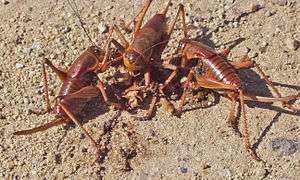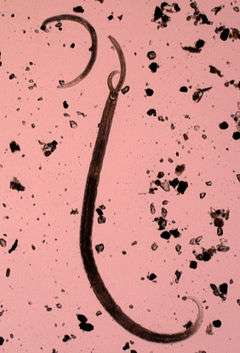Cannibalism (zoology)

In zoology, cannibalism is the act of one individual of a species consuming all or part of another individual of the same species as food. To consume the same species or show cannibalism is a common ecological interaction in the animal kingdom and has been recorded for more than 1,500 species.[1] It does not, as once believed, occur only as a result of extreme food shortages or artificial conditions, but commonly occurs under natural conditions in a variety of species.[1][2][3] Cannibalism seems to be especially prevalent in aquatic communities, in which up to approximately 90% of the organisms engage in cannibalism at some point of the life cycle. Cannibalism is also not restricted to carnivorous species, but is commonly found in herbivores and detritivores.[2]
Sexual cannibalism
Sexual cannibalism is a special case of cannibalism in which a female organism kills and consumes a conspecific male before, during, or after copulation. Rarely, these roles are reversed.[4][5] Sexual cannibalism has been recorded in the female redback spider, black widow spider, praying mantis, and scorpion, among others.
Size-structured cannibalism

Size-structured cannibalism is cannibalism in which older, larger, more mature individuals consume smaller, younger conspecifics. In size-structured populations, (where populations are made of individuals of various sizes, ages, and maturities), cannibalism can be responsible for 8% (Belding's ground squirrel) to 95% (dragonfly larvae) of the total mortality,[6] making it a significant and important factor for population[7] and community dynamics.[8]
Size-structured cannibalism has commonly been observed in the wild for a variety of taxa. Vertebrate examples include chimpanzees, where groups of adult males have been observed to attack and consume infants.[9][10][11]
Filial cannibalism
Filial cannibalism is a specific type of size-structured cannibalism in which adults eat their own offspring.[12] Though most often thought of as parents eating live young, filial cannibalism includes parental consumption of stillborn infants and miscarried fetuses as well as infertile and still-incubating eggs. Vertebrate examples include pigs, where savaging accounts for a sizable percentage of total piglet deaths, and cats.[13]
Filial cannibalism is particularly common in teleost fishes, appearing in at least seventeen different families of teleosts.[14] Within this diverse group of fish, there have been many, variable explanations of the possible adaptive value of filial cannibalism. One of these is the energy-based hypothesis, which suggests that fish eat their offspring when they are low on energy as an investment in future reproductive success.[12] This has been supported by experimental evidence, showing that male three-spined sticklebacks,[12][15][16] male tessellated darters,[17] and male sphinx blenny fish[18] all consume or absorb their own eggs to maintain their physical conditions. In other words, when males of a fish species are low on energy, it might sometimes be beneficial for them to feed on their own offspring to survive and invest in future reproductive success.
Another hypothesis as to the adaptive value of filial cannibalism in teleosts is that it increases density-dependent egg survivorship. In other words, filial cannibalism simply increases overall reproductive success by helping the other eggs make it to maturity by thinning out the numbers. Possible explanations as to why this is so include increasing oxygen availability to the remaining eggs,[19] the negative effects of accumulating embryo waste,[20] and predation.[20]
In some species of eusocial wasps, such as P. chinensis, the reproducing female will kill and feed younger larvae to her older brood. This occurs under food stressed conditions in order to ensure that the first generation of workers emerges without delay. [21] Further evidence also suggests that occasionally filial cannibalism might be the unfortunate by-product of cuckoldry in fish. Males consume broods, which may include their own offspring, when they believe a certain percentage of the brood contains genetic material that is not theirs.[15][22]
The dinosaur Coelophysis was once suspected to practice this form of cannibalism but this turned out to be wrong, although Deinonychus may have done. Skeletal remains from subadults with missing parts are suspected of having been eaten by other Deinonychus, mainly full-grown adults.
Infanticide
Infanticide is the killing of a non-adult animal by an adult of the same species. Infanticide is often, but not always, accompanied by cannibalism. It is often displayed in lions; a male lion encroaching on the territory of a rival pride will often kill any existing cubs fathered by other males; this brings the lionesses into heat more quickly, enabling the invading lion to sire his own young. This is a good example of cannibalistic behavior in a genetic context.
Intrauterine cannibalism
Intrauterine cannibalism is a behaviour in some carnivorous species, in which multiple embryos are created at impregnation, but only one or two are born. The larger or stronger ones consume their less-developed siblings as a source of nutrients.
In adelphophagy or embryophagy, the fetus eats sibling embryos, while in oophagy it feeds on eggs.[23][24]
Adelphophagy occur in some marine gastropods (calyptraeids, muricids, vermetids, and buccinids) and in some marine annelids (Boccardia proboscidia in Spionidae).[25]
Intrauterine cannibalism is known to occur in lamnoid sharks[26] such as the sand tiger shark, and in the Fire Salamander,[27] as well as in some teleost fishes.[24] The Carboniferous period chimaera, Delphyodontos dacriformes, is suspected of having practiced intrauterine cannibalism, also, due to the sharp teeth of the recently born (or possibly aborted) juveniles, and the presence of fecal matter in the juveniles' intestines.[28]
See also
References
- 1 2 G. A. Polis, The evolution and dynamics of intraspecific predation. Annual Review of Ecology and Systematics 12, 225-251 (1981).
- 1 2 Laurel R. Fox, Cannibalism in natural populations. Annual Review of Ecology and Systematics 6, 87-106 (1975).
- ↑ M. A. Elgar and B. J. (eds) Crespi, Cannibalism: Ecology and evolution among diverse taxa. (Oxford University Press, New York, 1992).
- ↑ Kenwyn Blake Suttle (1999). "The Evolution of Sexual Cannibalism". University of California, Berkeley.
- ↑ Min-Li Tsai & Chang-Feng Dai (2003). "Cannibalism within mating pairs of the parasitic isopod Ichthyoxenus fushanensis" (abstract page). Journal of Crustacean Biology. 23 (3): 662–668. doi:10.1651/C-2343.
- ↑ G. A. Polis, The evolution and dynamics of intraspecific predation. Annual Review of Ecology and Systematics 12, 225-251 (1981)
- ↑ David Claessen, A. M. De Roos, and L. Persson, Population dynamic theory of size-dependent cannibalism. Proceedings of the Royal Society of London Series B-Biological Sciences 271 (1537), 333-340 (2004)
- ↑ V. H. W. Rudolf, Consequences of stage-structured predators: Cannibalism, behavioral effects and trophic cascades. Ecology 88, 2991-3003 (2007)
- ↑ A. C. Arcadi and R. W. Wrangham, Infanticide in chimpanzees: Review of cases and a new within-group observation from the Kanyawara study group in Kibale National Park. Primates 40 (2), 337-351 (1999).
- ↑ M. L. Wilson, W. R. Wallauer, and A. E. Pusey, New cases of intergroup violence among chimpanzees in Gombe National Park, Tanzania. International Journal Of Primatology 25 (3), 523-549 (2004).
- ↑ D. P. Watts, J. C. Mitani, and H. M. Sherrow, New cases of inter-community infanticide by male chimpanzees at Ngogo, Kibale National Park, Uganda. Primates 43 (4), 263-270 (2002)
- 1 2 3 Rohwer, S. 1978. Parent Cannibalism of Offspring and Egg Raiding as a Courtship Strategy. American Naturalist 112:429-440.
- ↑ Hartwell, S, Cats that kill kittens
- ↑ Manica, A. 2002. Filial cannibalism in teleost fish. Biological Reviews 77:261-277.
- 1 2 Mehlis, M., T. C. M. Bakker, L. Engqvist, and J. G. Frommen. 2010. To eat or not to eat: egg-based assessment of paternity triggers fine-tuned decisions about filial cannibalism. Proceedings of the Royal Society B-Biological Sciences 277:2627-2635.
- ↑ Mehlis, M., T. C. M. Bakker, and J. G. Frommen. 2009. Nutritional benefits of filial cannibalism in three-spined sticklebacks (Gasterosteus aculeatus). Naturwissenschaften 96:399-403.
- ↑ DeWoody, J. A., D. E. Fletcher, S. D. Wilkins, and J. C. Avise. 2001. Genetic documentation of filial cannibalism in nature. Proceedings of the National Academy of Sciences of the United States of America 98:5090-5092.
- ↑ Kraak, S. B. M. 1996. Female preference and filial cannibalism in Aidablennius sphynx (Teleostei, Blenniidae); a combined field and laboratory study. Behavioural Processes 36:85-97.
- ↑ Payne, A. G., C. Smith, and A. C. Campbell. 2002. Filial cannibalism improves survival and development of beaugregory damselfish embryos. Proceedings of the Royal Society of London Series B-Biological Sciences 269:2095-2102.
- 1 2 Klug, H., K. Lindstrom, and C. M. S. Mary. 2006. Parents benefit from eating offspring: density-dependent egg survivorship compensates for filial cannibalism. Evolution 60:2087-2095.
- ↑ Kudo, K.; Shirai, A. (5 January 2012). "Effect of food availability on larval cannibalism by foundresses of the paper wasp Polistes chinensis antennalis". Insect Soc. 59: 279–284.
- ↑ Gray, S. M., L. M. Dill, and J. S. McKinnon. 2007. Cuckoldry incites cannibalism: male fish turn to cannibalism when perceived certainty of paternity decreases. American Naturalist 169:258-263.
- ↑ Thierry Lodé 2001. Les stratégies de reproduction des animaux (reproduction strategies in animal kingdom). Eds Dunod Sciences, Paris
- 1 2 Crespi, Bernard; Christina Semeniuk (2004). "Parent-Offspring Conflict in the Evolution of Vertebrate Reproductive Mode". The American Naturalist. 163 (5): 635–654. doi:10.1086/382734. PMID 15122484.
- ↑ Thomsen O., Collin R. & Carrillo-Baltodano A. (2014). "The Effects of Experimentally Induced Adelphophagy in Gastropod Embryos". PLoS ONE 9(7): e103366. doi:10.1371/journal.pone.0103366.
- ↑ Hamlett, William C.; Allison M. Eulitt; Robert L. Jarrell; Matthew A. Kelly (1993). "Uterogestation and placentation in elasmobranchs". Journal of Experimental Zoology. 266 (5): 347–367. doi:10.1002/jez.1402660504.
- ↑ Stebbins, Robert C.; Nathan W. Cohen (1995). A Natural History of Amphibians. Princeton, NJ: Princeton University Press. p. 9. ISBN 0-691-10251-1.
- ↑ Lund, R. 1980. Viviparity and intrauterine feeding in a new holocephalan fish from the Lower Carboniferous of Montana. Science, 209: 697‑699.
Further reading
| Wikimedia Commons has media related to Animal cannibalism. |
- M. A. Elgar and Bernard J. Crespi (eds.). 1992. Cannibalism: Ecology and Evolution of Cannibalism among Diverse Taxa Oxford University Press, New York. (361pp) ISBN 0-19-854650-5
